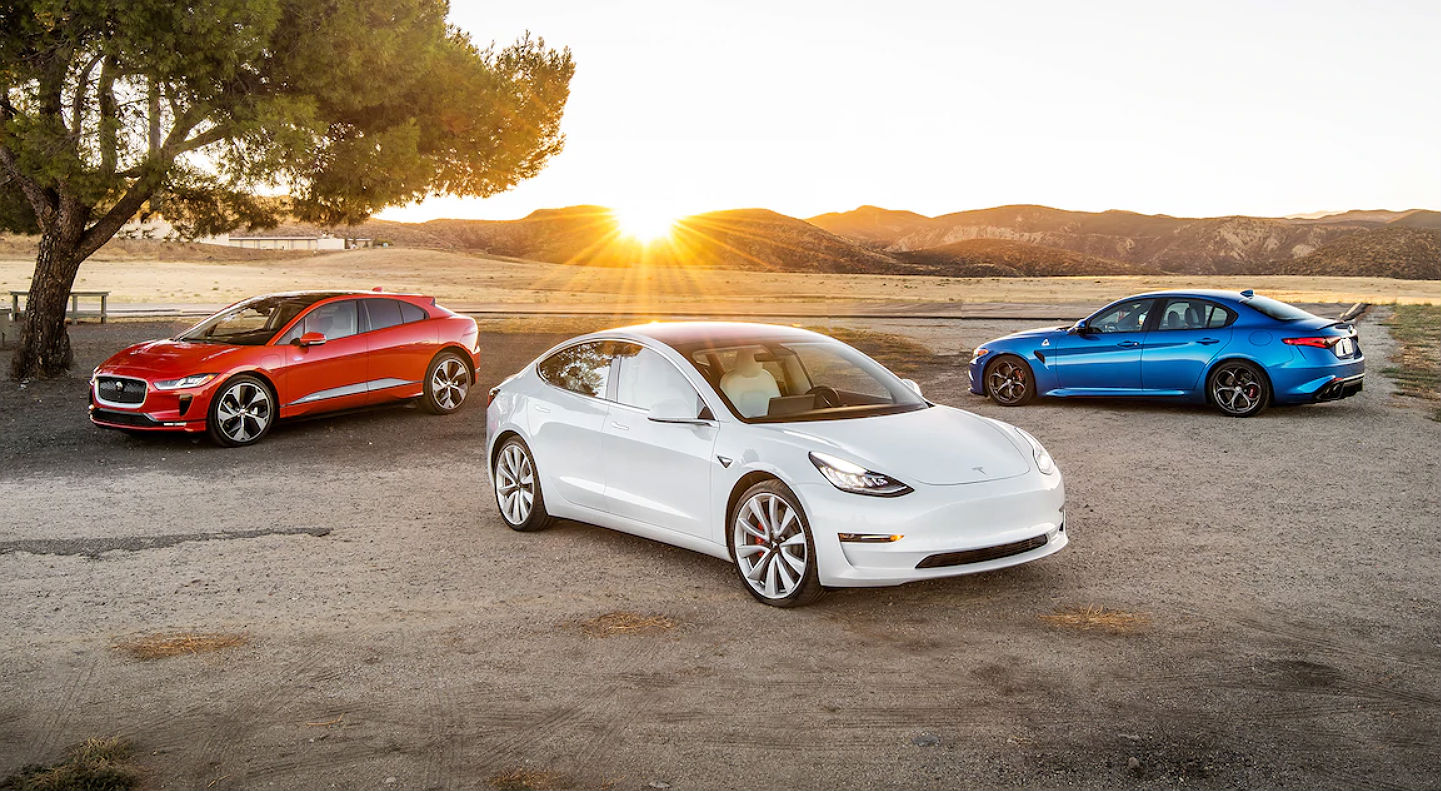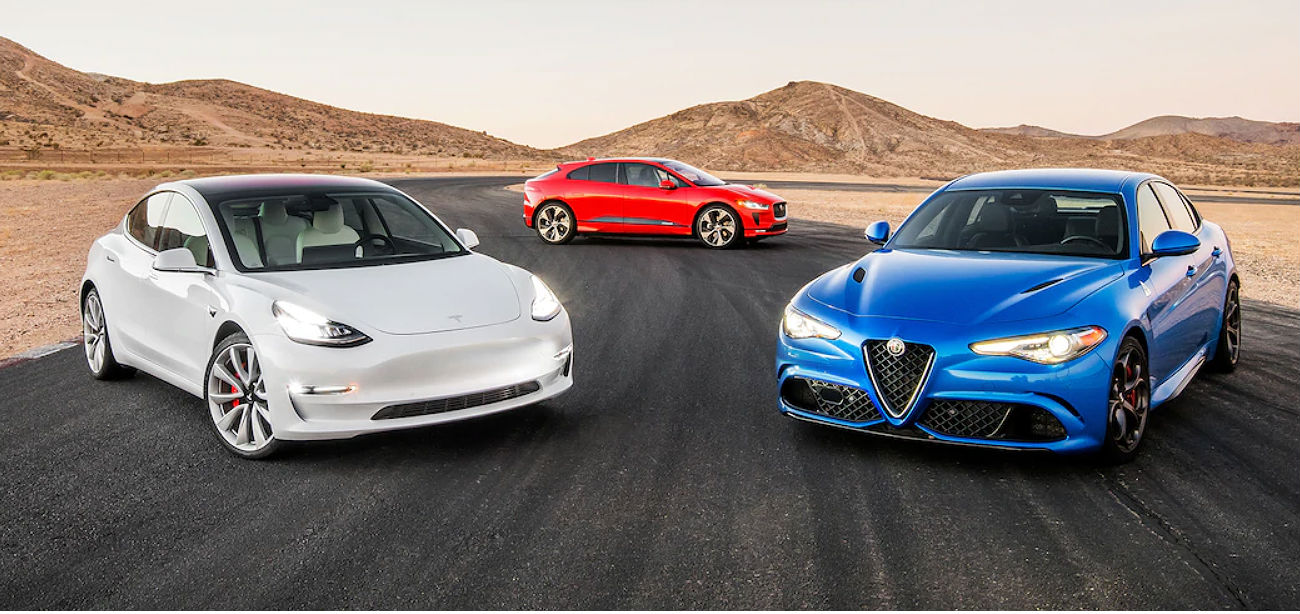

News
Tesla Model 3 with ‘Track Mode’ squares off against Jaguar I-PACE and MotorTrend’s top rated sports sedan
While the Model S and the Model X are monsters on the drag strip, the premium electric cars have developed a reputation for being ineffective during extended track driving. Tesla aims to shatter this perception with the Model 3 Performance, as the vehicle is designed to be the first of the company’s electric cars that is competitive on the racecourse. Tesla is even preparing a specific and aptly-named mode for the vehicle to achieve this goal — “Track Mode.”
The Tesla Model 3 Performance has been getting universally positive reviews from numerous publications, from the Wall Street Journal to Car & Driver. Reviewers have praised the vehicle for its handling and quickness, as well as its sheer fun factor when driven hard. Auto publication Road & Track even sampled the Model 3 Performance’s upcoming “Track Mode” feature, which allows the vehicle to perform impressive high-speed maneuvers on a racecourse.
Tesla’s Track Mode for the Model 3 Performance was recently put to the test by auto publication MotorTrend, which held comparative tests pitting the electric sedan against the Alfa Romeo Giulia Quadrifoglio, as well as another all-electric car, the Jaguar I-PACE EV400. The tests, which involved track testing all three vehicles by veteran race driver Randy Franklin Pobst, allowed the publication to analyze how the Model 3 Performance stacks up against a fellow track-capable EV and the best fossil fuel-powered sports sedan available today.
Needless to say, the results of the tests were very compelling.
It was easy to determine that among the three, the Jaguar I-PACE EV400 was at a disadvantage, particularly due to its 4,946-pound mass and its substantial ride height. The I-PACE’s electric motors, which produce a combined 394 horsepower, are also 22% less than the Giulia Quadrifoglio. These disadvantages were evident when the veteran driver took the electric crossover around the “Streets” of Willow Springs International Raceway in CA, as the I-PACE took 1:27.00 to complete a lap.
The difference between the track capabilities of the Model 3 Performance and the Alfa Romeo Giulia Quadrifoglio was far more difficult to call. With Track Mode enabled, the Model 3 Performance set a new record for production electric cars on the racecourse, completing the run at 1:23.90. That’s 0.07 seconds faster than one of Ford’s best track vehicles, the Mustang GT Performance Pack 2. That said, Pobst, who was driving the Model 3 Performance, noted that the vehicle was easy to understeer, and that “there’s something weird happening when I lift off the brake.” The sensation that the race driver was referring to was the Model 3 Performance’s regenerative braking, which is emphasized even more when Track Mode is enabled.
True to its reputation as the best sports sedan in the market today, the Alfa Romeo Giulia Quadrifoglio completed the lap in 1:22.78, 1.12 seconds faster than the Model 3 Performance. Pobst noted that the turbocharged V6-powered vehicle “does exactly what you expect. No surprises. Always predictable.” After two sets of hard laps, though, half of the Alfa Romeo’s Pirelli P Zero Corsa AR Asimmetrico front tires were all but gone. The Model 3 Performance’s Michelin Pilot Sport 4S tires, on the other hand, were at worst scuffed. A Tesla engineer remarked to the publication that the Model 3 Performance could match the Giulia Quadrifoglio’s time if they were willing to compromise the vehicle’s tires as well.

Ultimately, MotorTrend‘s track tests show that the Model 3 Performance, at its current state, is still not quite enough to topple the auto market’s best sports sedan. That said, Track Mode, despite being a work in progress, is a very strong baseline. The publication noted that for now, it would be wise to look at Tesla’s Track Mode for the Model 3 Performance as Version 1.0 of the feature. Once Version 2.0 is ready, then vehicles such as the Alfa Romeo Giulia Quadrifoglio would also be wise to fear Tesla’s first track-capable vehicle.
Even without Track Mode, the Tesla Model 3 Performance is already starting to win over veteran auto enthusiasts, including longtime enthusiasts of legacy carmakers like BMW. Moshen Chan, an indie app developer who has been a BMW fan for ~20 years, noted that Tesla’s electric car “absolutely outperforms anything BMW has to offer today.”
The Model 3 Performance’s Track Mode is one of the electric sedan’s most compelling features. Describing the feature in an interview with YouTube tech host Marques Brownlee, Musk likened Track Mode as an “Expert User Mode” for drivers.
“Track Mode will open up a lot of settings. You can adjust settings, and it’s kinda like an ‘Expert User Mode.’ You can sort of adjust traction control, adjust battery temperature. You can basically configure a bunch of things, and it will tell you, like ‘Hey, you know if you do this, it’s a bit risky. You’re gonna wear out your brakes sooner; you might blow a circuit.’ But like, it’ll be clear — like, you know, this is the risk you’re taking. It’s kinda like if you have a graphics card in a computer. You can go in there and change the settings, and you can overclock things,” Musk said.

News
Tesla China quietly posts Robotaxi-related job listing
Tesla China is currently seeking a Low Voltage Electrical Engineer to work on circuit board design for the company’s autonomous vehicles.

Tesla has posted a new job listing in Shanghai explicitly tied to its Robotaxi program, fueling speculation that the company is preparing to launch its dedicated autonomous ride-hailing service in China.
As noted in the listing, Tesla China is currently seeking a Low Voltage Electrical Engineer to work on circuit board design for the company’s autonomous vehicles.
Robotaxi-specific role
The listing, which was shared on social media platform X by industry watcher @tslaming, suggested that Tesla China is looking to fill the role urgently. The job listing itself specifically mentions that the person hired for the role will be working on the Low Voltage Hardware team, which would design the circuit boards that would serve as the nervous system of the Robotaxi.
Key tasks for the role, as indicated in the job listing, include collaboration with PCB layout, firmware, mechanical, program management, and validation teams, among other responsibilities. The role is based in Shanghai.
China Robotaxi launch
China represents a massive potential market for robotaxis, with its dense urban centers and supportive policies in select cities. Tesla has limited permission to roll out FSD in the country, though despite this, its vehicles have been hailed as among the best in the market when it comes to autonomous features. So far, at least, it appears that China supports Tesla’s FSD and Robotaxi rollout.
This was hinted at in November, when Tesla brought the Cybercab to the 8th China International Import Expo (CIIE) in Shanghai, marking the first time that the autonomous two-seater was brought to the Asia-Pacific region. The vehicle, despite not having a release date in China, received a significant amount of interest among the event’s attendees.
Elon Musk
Elon Musk and Tesla AI Director share insights after empty driver seat Robotaxi rides
The executives’ unoccupied tests hint at the rapid progress of Tesla’s unsupervised Robotaxi efforts.

Tesla CEO Elon Musk and AI Director Ashok Elluswamy celebrated Christmas Eve by sharing personal experiences with Robotaxi vehicles that had no safety monitor or occupant in the driver’s seat. Musk described the system’s “perfect driving” around Austin, while Elluswamy posted video from the back seat, calling it “an amazing experience.”
The executives’ unoccupied tests hint at the rapid progress of Tesla’s unsupervised Robotaxi efforts.
Elon and Ashok’s firsthand Robotaxi insights
Prior to Musk and the Tesla AI Director’s posts, sightings of unmanned Teslas navigating public roads were widely shared on social media. One such vehicle was spotted in Austin, Texas, which Elon Musk acknowleged by stating that “Testing is underway with no occupants in the car.”
Based on his Christmas Eve post, Musk seemed to have tested an unmanned Tesla himself. “A Tesla with no safety monitor in the car and me sitting in the passenger seat took me all around Austin on Sunday with perfect driving,” Musk wrote in his post.
Elluswamy responded with a 2-minute video showing himself in the rear of an unmanned Tesla. The video featured the vehicle’s empty front seats, as well as its smooth handling through real-world traffic. He captioned his video with the words, “It’s an amazing experience!”
Towards Unsupervised operations
During an xAI Hackathon earlier this month, Elon Musk mentioned that Tesla owed be removing Safety Monitors from its Robotaxis in Austin in just three weeks. “Unsupervised is pretty much solved at this point. So there will be Tesla Robotaxis operating in Austin with no one in them. Not even anyone in the passenger seat in about three weeks,” he said. Musk echoed similar estimates at the 2025 Annual Shareholder Meeting and the Q3 2025 earnings call.
Considering the insights that were posted Musk and Elluswamy, it does appear that Tesla is working hard towards operating its Robotaxis with no safety monitors. This is quite impressive considering that the service was launched just earlier this year.
Elon Musk
Starlink passes 9 million active customers just weeks after hitting 8 million
The milestone highlights the accelerating growth of Starlink, which has now been adding over 20,000 new users per day.

SpaceX’s Starlink satellite internet service has continued its rapid global expansion, surpassing 9 million active customers just weeks after crossing the 8 million mark.
The milestone highlights the accelerating growth of Starlink, which has now been adding over 20,000 new users per day.
9 million customers
In a post on X, SpaceX stated that Starlink now serves over 9 million active users across 155 countries, territories, and markets. The company reached 8 million customers in early November, meaning it added roughly 1 million subscribers in under seven weeks, or about 21,275 new users on average per day.
“Starlink is connecting more than 9M active customers with high-speed internet across 155 countries, territories, and many other markets,” Starlink wrote in a post on its official X account. SpaceX President Gwynne Shotwell also celebrated the milestone on X. “A huge thank you to all of our customers and congrats to the Starlink team for such an incredible product,” she wrote.
That growth rate reflects both rising demand for broadband in underserved regions and Starlink’s expanding satellite constellation, which now includes more than 9,000 low-Earth-orbit satellites designed to deliver high-speed, low-latency internet worldwide.
Starlink’s momentum
Starlink’s momentum has been building up. SpaceX reported 4.6 million Starlink customers in December 2024, followed by 7 million by August 2025, and 8 million customers in November. Independent data also suggests Starlink usage is rising sharply, with Cloudflare reporting that global web traffic from Starlink users more than doubled in 2025, as noted in an Insider report.
Starlink’s momentum is increasingly tied to SpaceX’s broader financial outlook. Elon Musk has said the satellite network is “by far” the company’s largest revenue driver, and reports suggest SpaceX may be positioning itself for an initial public offering as soon as next year, with valuations estimated as high as $1.5 trillion. Musk has also suggested in the past that Starlink could have its own IPO in the future.








